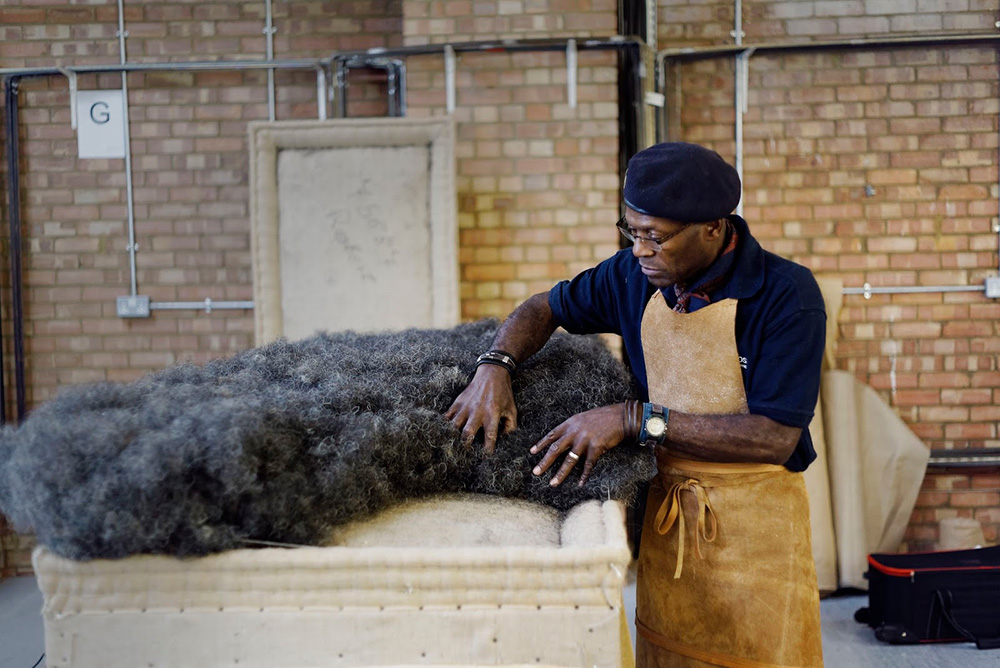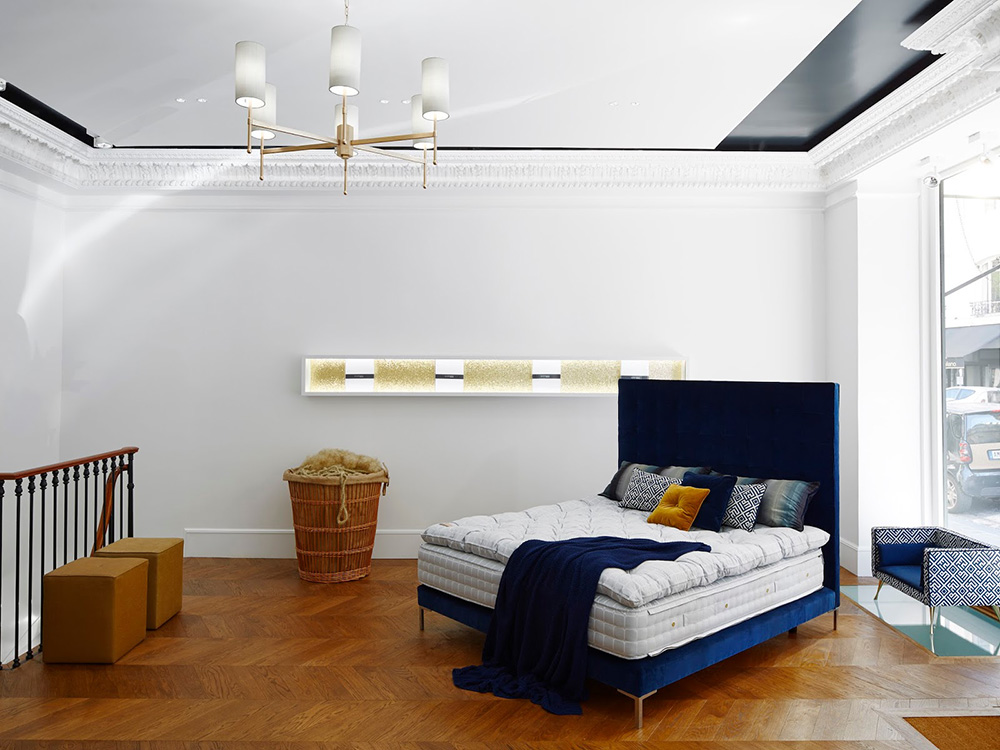FOR AN INDUSTRY THAT HAS LONG BEEN SHROUDED IN SECRECY, TRANSPARENCY IS QUICKLY BECOMING THE WINNING STRATEGY.

WORDS: JOSH KRAUS | IMAGES: JAMES FLORIO
IF YOU’RE EVER CURIOUS ABOUT WHAT’S ACTUALLY INSIDE A MATTRESS, STEVE VAN DIEST IS HAPPY TO SHOW YOU. “WHAT’S IN THIS BOND BED? I DON’T KNOW, LET’S TAKE A LOOK,” SAID VAN DIEST, OWNER OF THE DENVER-BASED MATTRESS FRANCHISE URBAN MATTRESS. HE THEN PICKED UP A CROSS-SECTION OF THE BOND MATTRESS AND POINTED TO EACH INDIVIDUAL LAYER. “NATURAL SOY BASED POLYURETHANE, LATEX, MERINO LAMBSWOOL …”
This cross-section, which resembles the world’s largest and fuzziest slice of cake, speaks to Urban Mattress’s overarching philosophy of honesty and customer education. Van Diest believes in arming customers with the knowledge necessary to make an informed purchasing decision, and believe it or not, that’s a fairly novel idea for someone so deeply embedded in this industry. To understand why Van Diest is something of a rarity, a brief history lesson is in order.
Spurred by the invention of the box-spring in the late 1800s, the mattress industry truly emerged at the turn of the century. Stearns and Foster was one of the country’s first mattress manufacturers, followed by Simmons, Sealy, and Serta, just to name a few. These companies came to be known as the Big S brands, and although hundreds more manufacturers surfaced over time, the Big S brands proceeded to dominate the market.
With so much power in the hands of so few, the Big S brands were able to control the flow of product information, leaving consumers in the dark as to what exactly was inside their mattresses. Comparison shopping became impossible, and price gouging became the new normal.
But in the age of the Internet, it became more difficult to hide information, and the robber baron tactics of the Big S brands started coming to light. Websites like The Mattress Underground began divulging industry secrets, and consumers grew more savvy to the industry’s shady practices. It was only a matter of time before honesty and transparency came in vogue. “We play a higher road,” Van Diest said. “Urban Mattress, for example, is not going to be your big-box store, wheeling and dealing. We want to be very upfront.”
Rather than pledge allegiance to the Big S brands, Urban Mattress hunts down the best quality products at the best price point. What’s more, its sales staff is typically comprised of former teachers or nonprofit workers, not trained salesmen. “We look for people who like people, who want to help their community,” Van Diest said. It’s likely, then, that he would find a kindred spirit in Rob Rollins, owner of Colorado Mattress Company in Vail. “I want the industry to be honest,” said Rollins. “I look people in the eyes and say, ‘Hey, let’s find a bed that works for you.’”
As a small retailer, Rollins is adamant about aligning himself with only the most trustworthy vendors, such as Sherwood Bedding, out of Phoenix, who consistently fight against cost-cutting measures that would yield lower-quality products. “It takes a lot of integrity in the industry to push back against pencil pushers,” Rollins said.
You’d be hard-pressed to find a more honest mattress salesman than Rollins. His unflinching commitment to transparency and customer education strikes a chord with today’s increasingly disillusioned shoppers. In fact, he just had his best fiscal year to date. “What beats in this new hipster heartbeat is local, pure, honest, and real,” Van Diest said.
While Van Diest and Rollins are challenging the status quo through brick-and-mortar operations, a slew of mattress startups is shaking things up from the online arena. In 2013, the same year that Tempur-Pedic merged with Sealy’s, online mattress manufacturers Tuft & Needle and Casper launched to great success. Along with other mattress e-companies like Leesa and Saatva, these newcomers are challenging the reigning mattress incumbents by focusing on convenience, affordability, and candor. “The Internet really gives people a whole other lens to look through to help them,” Rollins said. While these startups are certainly an answer to consumer frustrations, they’re also a product of recent technological advancements. “There’s a new paradigm,” Rollins said. “The technology has leaped forward exponentially over the last seven years. They’re using computers to design new foams, create things more organically, and make the beds stronger and more comfortable. I’ve never seen better products than now.” There is, indeed, a broad range of new and improved products, and if you’re ever stuck with a slippery salesman, it’s important to know how each product differs.
When you hack through all the buzzwords and sales talk, mattress quality rests on two basic principles: comfort and support. Comfort pertains to pressure relief, and for a mattress to provide optimal pressure relief, it must form a cradle that evenly distributes your body weight. The top layer of a mattress is responsible for comfort, and these days, comfort layers are typically made from latex, memory foam, polyurethane (polyfoam), buckling column gel, or microcoils. Gel and memory foam are generally the most expensive.
Support pertains to spinal alignment, and for a mattress to provide optimal spinal alignment, it must control how deep your body sinks into the mattress. The lower layers of a mattress are responsible for support and are typically made from innerspring, latex, or polyurethane, with innerspring being the least expensive option.
Understanding these two principles immediately puts you at an advantage. For example, if someone tries to sell you on the groundbreaking comfort of an innerspring core, proceed with caution. Innersprings make up the support layers, and have little to do with comfort. Inversely, if someone advertises the cutting edge support of a top layer, you know they’re spinning you a tale.
A little mattress knowledge can also provide insight into price points. Tuft & Needle’s mattress, for instance, is made from three customized layers of high-quality polyfoam. Casper’s mattress is made from three layers of polyfoam as well, but unlike its competitor, Casper uses memory foam for one of its layers. The added expense of memory foam contributes to Casper’s higher price point.
With so many types of mattresses and so many distribution channels, customers have more options than ever, and thus, more power. Where there was once a drought of information, there is now a flood, and while the Big S brands are still a force to be reckoned with, consumers are no longer beholden to them. As Rollins will tell you: “I really believe that this is the best time to buy a mattress.”
[divider scroll_text=””]
SWEET DREAMS ARE MADE OF THIS
LIKE CERTAIN SPECTRUMS OF LIGHT, THERE IS A TIER OF MATTRESS BRANDS SO HIGH-END THEY’RE NEARLY INVISIBLE TO THE NAKED EYE. AND EVEN THOUGH THEY ARE NOT COMMON HOUSEHOLD NAMES, SOME OF THEM HAVE EXISTED FOR OVER A CENTURY.

One of the world’s most expensive mattresses is the No. 1 by Savoir Beds. Started by the Savoy Group in 1905, Savoir Beds wants you to “spend a third of your life in first class,” and insists that the production of each mattress is assigned its own craftsman, who sees the process through from start to finish. This commitment to perfection is just one of the reasons why the No. 1 costs $90,000.
The No. 1’s high price tag is also informed by the materials. Rather than foam or gel, Savoir Beds stuffs its mattress topper with hand-teased Brazilian horse hair, which undergoes a two-year curing process before it’s ready for use. The topper’s outer layer is made from pure cashmere, and the support layers are built around hand-tied pocket springs. The total skilled production time for this mattress is 120 hours.
Another member of the mattress industry’s elite inner circle is the Swedish bedding company Hästens. Founded in 1852, Hästens has since become the Royal Court of Sweden’s official purveyor of bedding, which is fitting, as it takes a royal budget to afford these rectangular thrones. Hästens’ crowning jewel, the Vividus, will run you around $50,000 and is built primarily of horsehair, cotton, linen, and wool.
If you’re dead set on owning a high-end mattress, but refuse to part with a year’s salary, Vi-Spring, an English company, might be your saving grace. Their priciest model, the Masterpiece Superb, comes in at a (relatively) modest $20,000, and contains European horsetail, Shetland Isle wool, cashmere, and alpaca.
As you’ve probably noticed, high-end mattresses seem to favor animal products, which provide a myriad of unique physical properties not shared by their synthetic counterparts. Hand-teased horsehair, for instance, is extremely durable and doesn’t settle or collapse to the degree that other materials do. The hollow structure of horsehair also makes it incredibly breathable and allows it to quickly wick away accumulated moisture. Then there’s Shetland wool, which purportedly inhibits the growth of fungi, bacteria, and dust mites. It’s also hypoallergenic, fire retardant, and naturally responsive to body temperature. Of course, both of these materials are rare and expensive, which might explain the high price tag.
Many will tell you that the exorbitant prices aren’t justified, that buzzwords like hand-teased and hand-tied don’t a $90,000 mattress make. But here’s the thing: Someone buying a $90,000 mattress isn’t concerned about buzzwords or false advertising. They’re not worried about value. What matters to them is comfort, style, and luxury, and high-end mattresses deliver on all three fronts.
It may be difficult to find people who own $90,000 mattresses, but if you do, they’ll probably tell you that it changed their lives. They’ll cite relief from chronic back pain. They’ll tell you it all but cured their insomnia. Spending nearly six figures for a mattress may seem unbelievable, but $90,000 for a better life? Now that makes a little more sense.




